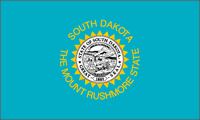


Geography and Landforms:
South Dakota is bordered by North Dakota to the north and by Nebraska to the south. On the east, South Dakota borders Minnesota and Iowa, and on the west, it borders Montana and Wyoming.
|
 History:
The first European explorers to travel through the area that is now South Dakota were French. Pierre Gaultier de Varennes, sieur de La Verendrye, and his two sons, Louis-Joseph and Francois, were in search of a water route from the Hudson Bay to the Pacific Ocean and explored extensively through Canada before finding their way to the Missouri River and the Dakota plains. While they were camping along the Missouri River in 1741, they buried a lead plate near the Bad River with an inscription that honored the King of France, Louis XV. The area came under French, Spanish and British control at various times during the 18th century. For example, the land went from French to British hands after the Treaty of Paris ended the French and Indian War. The British then gave the land back to the French and then the United States bought the land from France in the Louisiana Purchase in 1803.
|
 Economy:
South Dakota has long been an agricultural state, and although it is still an important part of the economy and the culture, farming no longer leads the state in employment. Nonetheless, South Dakota is the second-largest producer of flaxseed and sunflower seed in the nation, and the third largest producer of hay and rye. Corn, soybeans, oats and wheat are the chief cash crops.
|
 First Inhabitants:
Archaeologists have found evidence that a band of Paleo-Indians hunted and killed two mammoths around 11,000 years ago in a swampy area that would eventually become the Badlands area of South Dakota. These are first South Dakotans we know of. It is believed these people were part of a group called the Clovis people who were centered in New Mexico. We know from artifacts that they made arrowheads for hunting, but we know very little else about these people.
|
Books Related To South DakotaBlack-Eyed Susan - Jennifer Armstrong Buster Hits the Trail - Marc Brown The First Four Years - Laura Ingalls Wilder Go Big or Go Home - Will Hobbs M is for Mount Rushmore: A South Dakota Alphabet - William Anderson Prairie Winter - Bonnie Geisert |
Famous Citizens:
|
| Capital: | Pierre |
| Entered Union: | November 2, 1889 |
| Population: | 853,175 |
| Area | 77,116 |
| Bird | Ring-necked Pheasant |
| Flower | Pasque Flower |
| Nickname: | Mount Rushmore State |
| Governor | Dennis Daugaard |
Places to Visit in South Dakota: (Click the links to learn more.)
|



